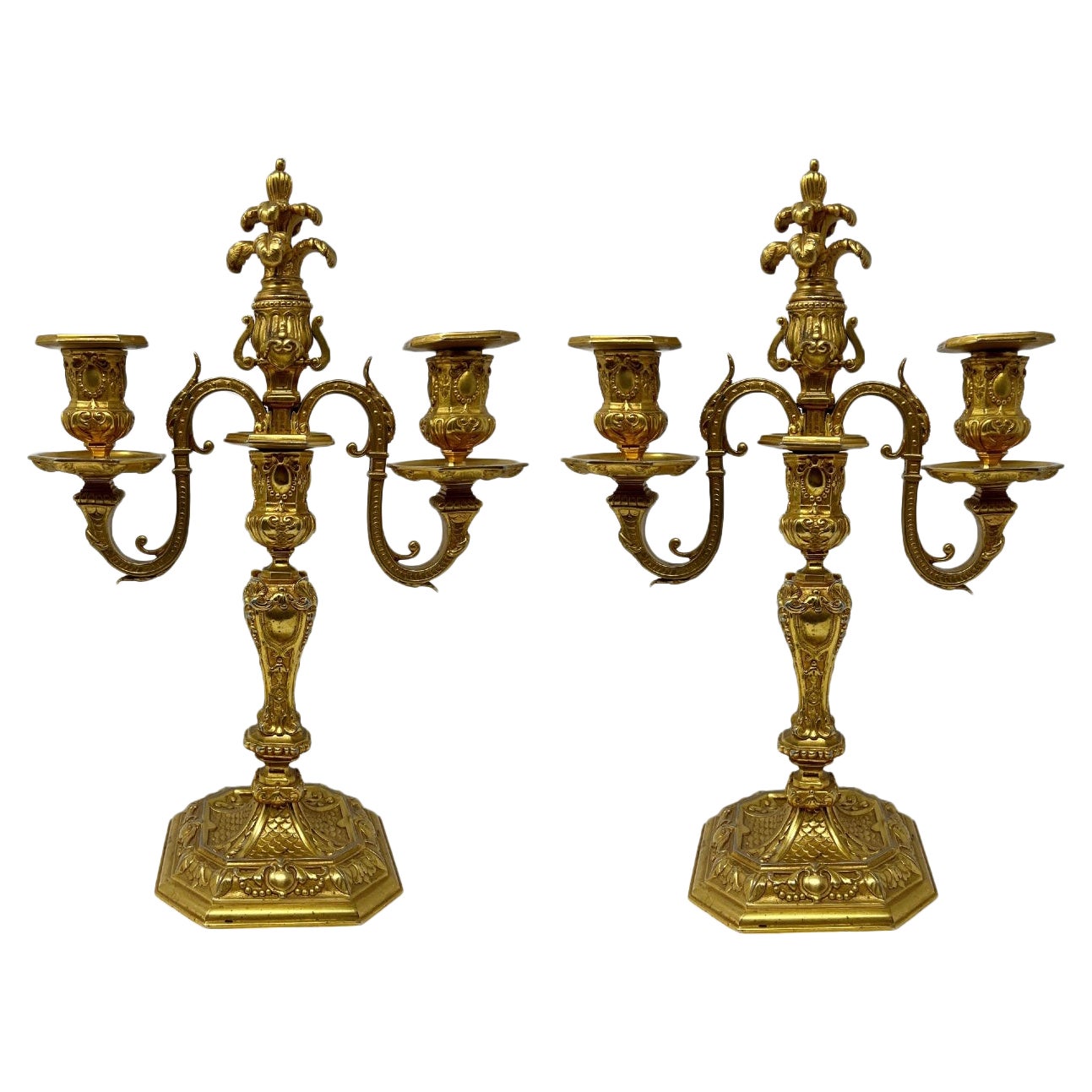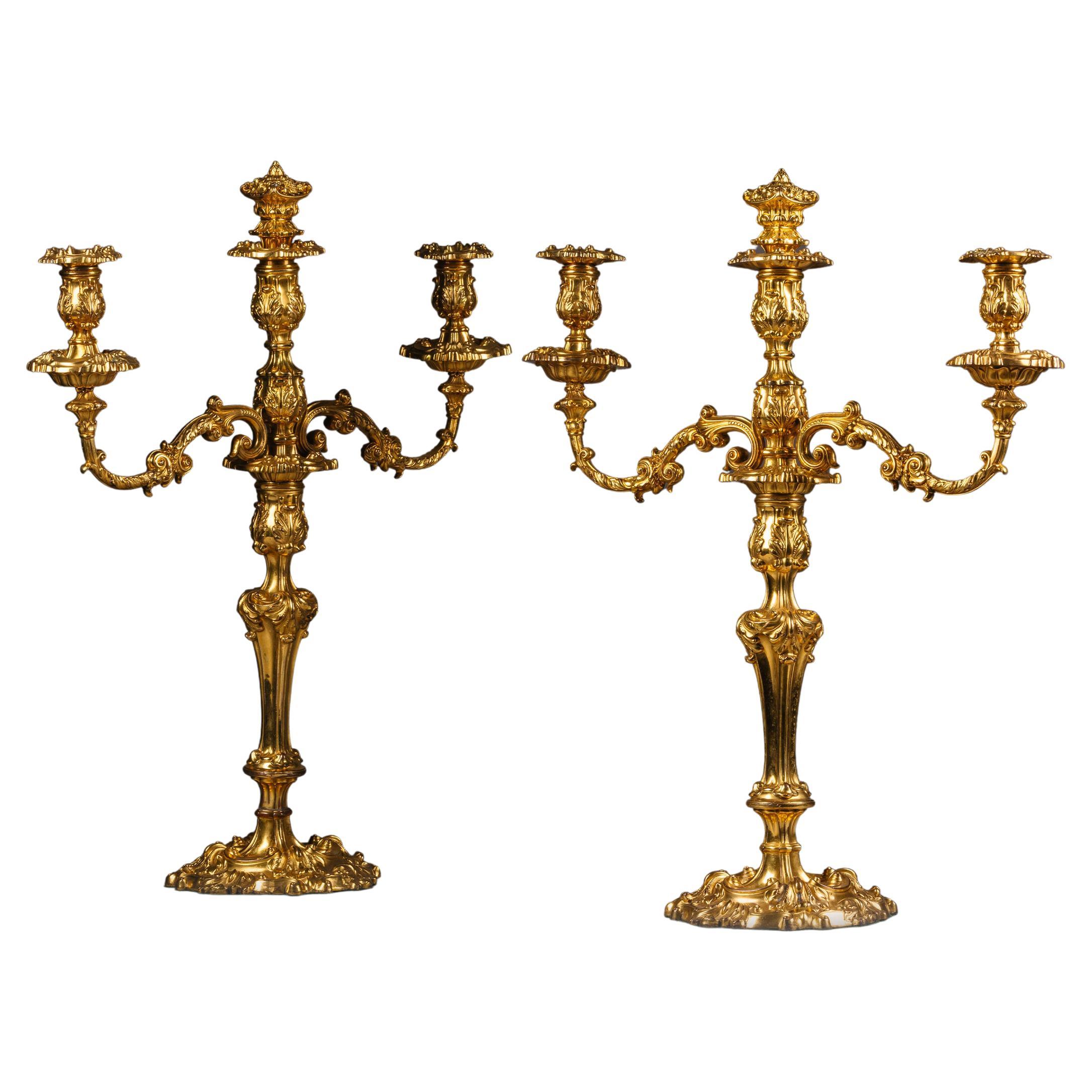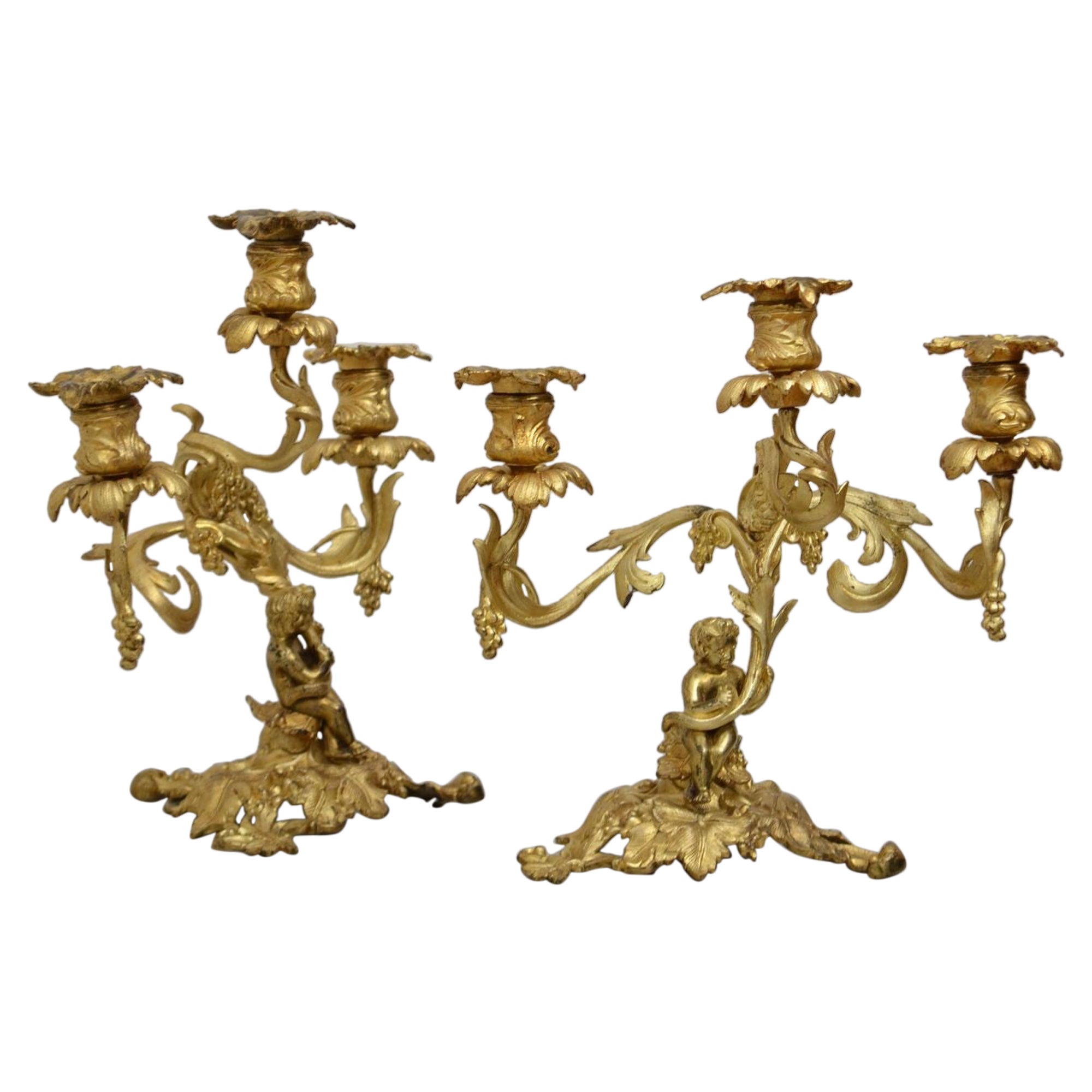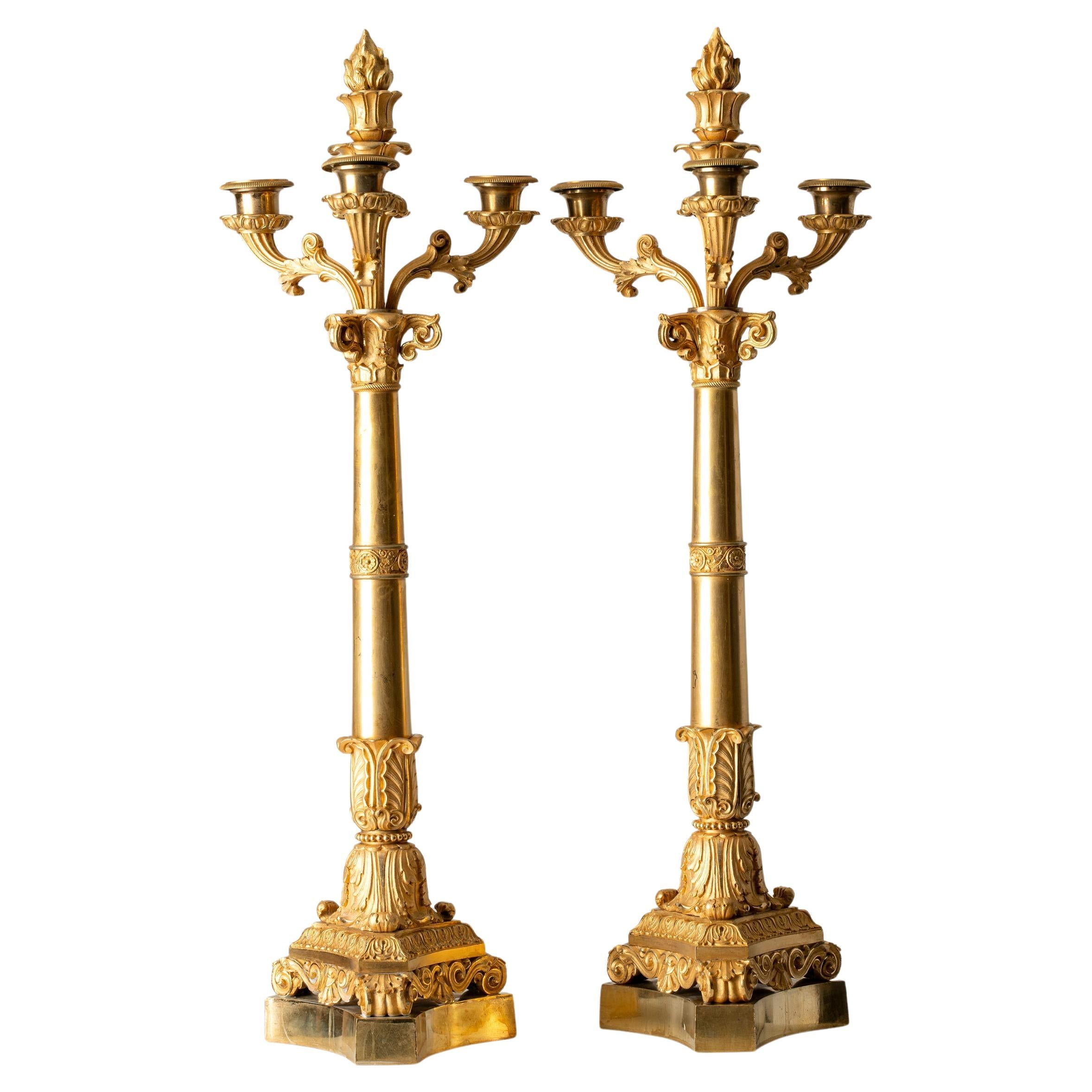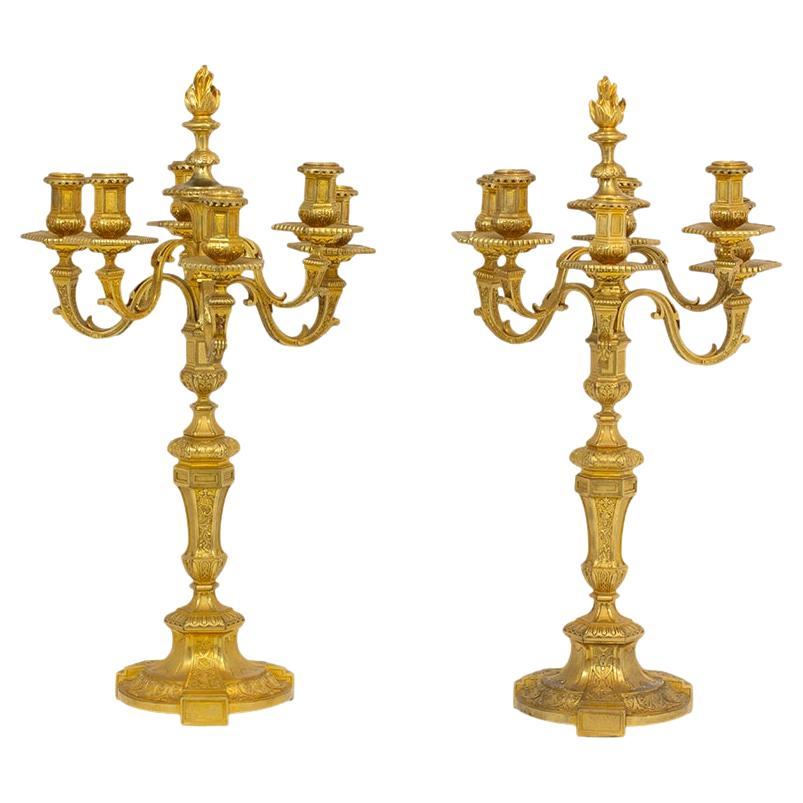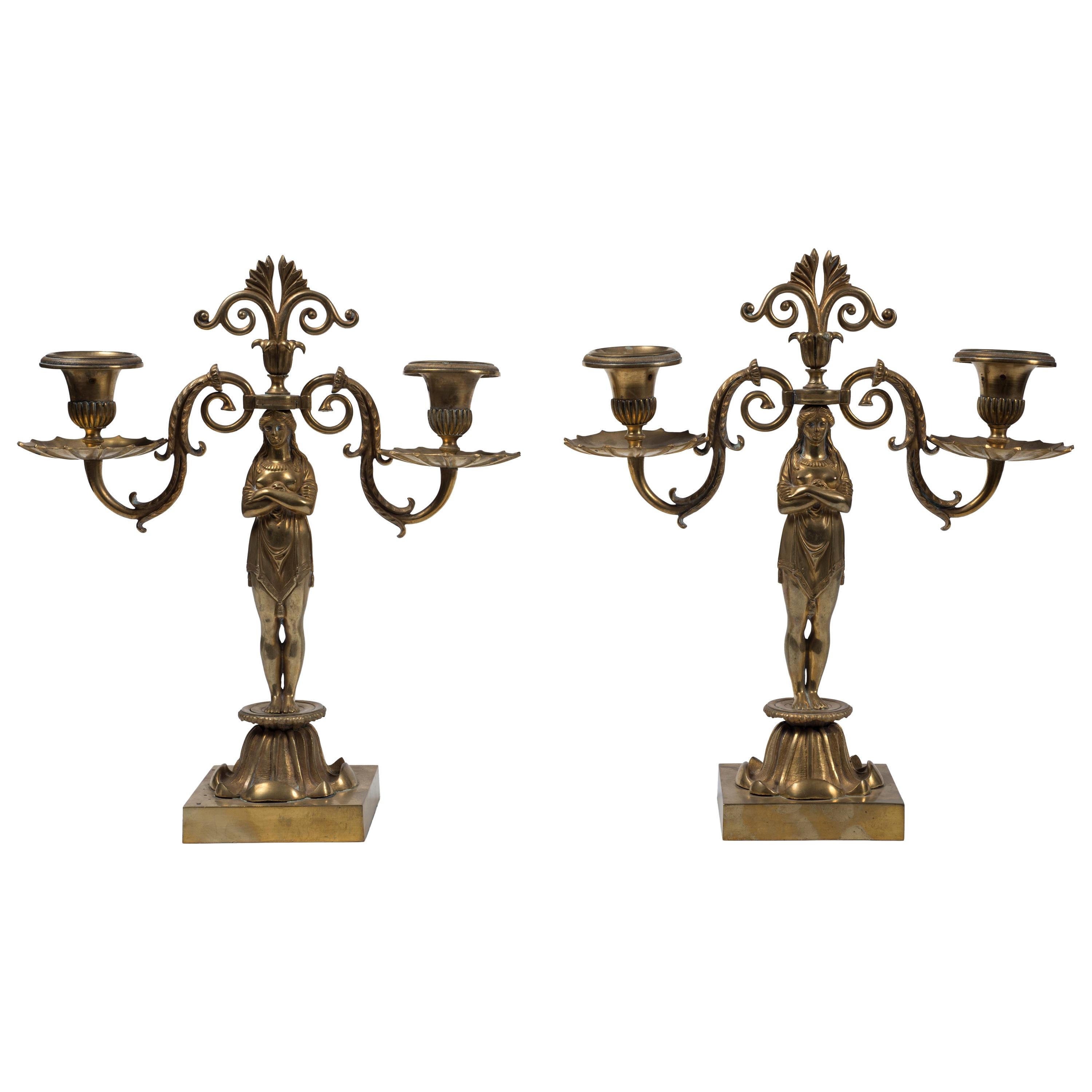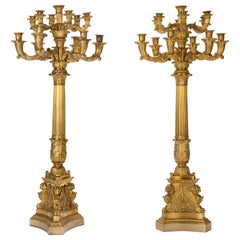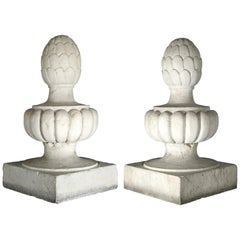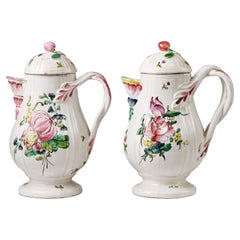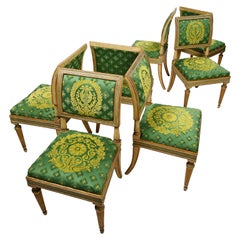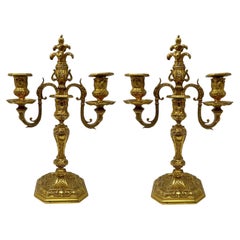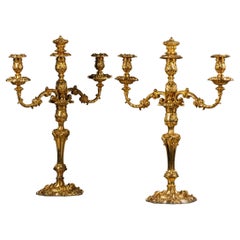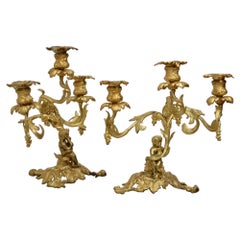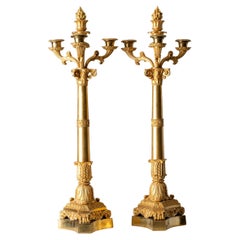Items Similar to Pair of French Three-Flame Candelabra Candelabra, circa 1860
Video Loading
Want more images or videos?
Request additional images or videos from the seller
1 of 19
Pair of French Three-Flame Candelabra Candelabra, circa 1860
$12,041.86per set
£8,909.47per set
€10,000per set
CA$16,650.02per set
A$18,279.64per set
CHF 9,536.53per set
MX$221,209.15per set
NOK 119,525.60per set
SEK 112,624.54per set
DKK 76,140.28per set
About the Item
Pair of three-flame candelabra
Cast bronze, chiselled and mercury gilded
France, third quarter of the nineteenth century
Height 14.96 in (38 cm) X 12.59 (32 cm)
Weight 11.46 lb (5.2 kg) each
State of conservation: very good
The two candelabra were made out of several elements of melted bronze, chiselled and then mercury gilded. The parts were later assembled to form the refined “flambeaux” with a sinuous articulated shape.
The hollow base has a shaped vertical edge that alternates curves with square plinths. The alternation of the geometric elements is repeated on the foot and stem in elegant chiselled ornaments. The ornamentation reflects a large part of the decorative repertoire of the time: frets, double hollow embossed, protruding frames and hollow gorges; festoons in relief around curled column capitals; continuous spiral creases with small spheres in the center.
In the upper portion the chalice is enriched with engraved lance-shaped leaflets and the arms branch off from double circlets of petals that surround a central cuspidate element ending in a closed bud filled with small spherical fruits. These are reproduced, in more minute forms, as an embellishment to the linear strokes as well as at the base of the bobèches.
The arms have a shape in keeping with the alternating curved and straight lines and widen around the stem. These terminate in elegant bobèches supported by a truncated cone element, which in turn holds the cylindrical candle-holder decorated with lance-shaped leaves alternating with sunken ashlar motifs.
The excellent gilding technique and the sophisticated decorative style with classical ornamental embellishments confirm that the two candelabra were produced in Paris for a high commission during the period of the Second Empire (1848-1870).
- Dimensions:Height: 14.97 in (38 cm)Diameter: 12.6 in (32 cm)
- Sold As:Set of 2
- Style:Napoleon III (Of the Period)
- Materials and Techniques:
- Place of Origin:
- Period:
- Date of Manufacture:Circa 1860
- Condition:Minor fading.
- Seller Location:Milano, IT
- Reference Number:1stDibs: LU4352214861412
About the Seller
4.3
Vetted Professional Seller
Every seller passes strict standards for authenticity and reliability
Established in 1860
1stDibs seller since 2018
21 sales on 1stDibs
Associations
International Confederation of Art and Antique Dealers' Associations
- ShippingRetrieving quote...Shipping from: Milano, Italy
- Return Policy
Authenticity Guarantee
In the unlikely event there’s an issue with an item’s authenticity, contact us within 1 year for a full refund. DetailsMoney-Back Guarantee
If your item is not as described, is damaged in transit, or does not arrive, contact us within 7 days for a full refund. Details24-Hour Cancellation
You have a 24-hour grace period in which to reconsider your purchase, with no questions asked.Vetted Professional Sellers
Our world-class sellers must adhere to strict standards for service and quality, maintaining the integrity of our listings.Price-Match Guarantee
If you find that a seller listed the same item for a lower price elsewhere, we’ll match it.Trusted Global Delivery
Our best-in-class carrier network provides specialized shipping options worldwide, including custom delivery.More From This Seller
View All19th Century Pair of French or Russian Gilt Bronze Candelabra, circa 1830
Located in Milano, IT
Pair of thirteen-flame candelabra
France or Russia
Second quarter of 19th century
Cast, chiseled and gilt bronze
Height 40.95 in (cm 104), diameter 17,7 in (cm 45)
97 lb (44 kg)
Sta...
Category
Antique 1830s French Neoclassical Candelabras
Materials
Ormolu
Italian Ancient Botticino Marble Pair of Pinnacles, circa 1850
Located in Milano, IT
Pair of pinnacles
Northern Italy, mid-19th century
Botticino marble, carved
They measure 33.1 inches in height x 17.7 x 17.7 (84 cm x 45 x 45)
State of conservation: some visible cracks and various small gaps.
The two twin architectural elements of sculpted Botticino marble have a quadrangular base from which a chalice-shaped foot extends. Resting on this, a round pod-like element swells up to support a large pine cone. This is the main decoration: however, the other ornamental details enhance and embellish it, while exalting its position above, whether observed from afar or up close.
These aesthetic characteristics suggest that originally the pair of pinnacles were placed on columns or on architectural plinths...
Category
Antique 1850s Italian Other Architectural Elements
Materials
Marble
Ancient Pair Coffee Pots, Pasquale Rubati Manufacture Milan, 1770 circa
By Pasquale Rubati
Located in Milano, IT
Pair of small coffee pots.
Manufacture of Pasquale Rubati
Milan, 1770 Circa
Maiolica polychrome decorated “a piccolo fuoco” (third fire).
a) height 7.87 x 5.51 x 3.93 in (20 x 14 x ...
Category
Antique 1760s Italian Neoclassical Ceramics
Materials
Maiolica
Seven Early 19th Century Neoclassical Italian Chairs, Milan circa 1820
Located in Milano, IT
Group of seven chairs
Milan, first quarter of the 19th century
Carved walnut wood, lacquered in gray green and cream and partially gilded
They measure:
height 36.61 in (18.11 in ...
Category
Antique 1810s Italian Neoclassical Chairs
Materials
Walnut
Two Small Italian Dishes Antonio Maria Coppellotti Manufacture, Lodi, Circa 1740
By Antonio Maria Coppellotti
Located in Milano, IT
Two small dishes
Antonio Maria Coppellotti Manufacture
Lodi, Circa 1740
High fire polychrome majolica
They measure: diameter 7.08 in(18 cm)
Weight: 0.37 lb (170 g)
State of conservat...
Category
Antique 1740s Italian Baroque Ceramics
Materials
Maiolica
Six Mid-18th Century Italian Chairs, Venice, circa 1750
Located in Milano, IT
Six carved walnut chairs
Venice, mid-18th century
Height 35.03 in (18.70 in to the seat) x 19.09 in x 18.30 in
(89 cm - 47.5 cm to the seat - x 48.5 cm x 46.5 cm)
lb 80 (kg 36)
Stat...
Category
Antique 1750s Italian Rococo Dining Room Chairs
Materials
Walnut
You May Also Like
Pair Antique French Francois Premier Bronze D'oré Candelabra, Circa 1880.
Located in New Orleans, LA
Pair Antique French Francois Premier Bronze D'oré Candelabra, Circa 1880.
Category
Antique Late 19th Century French Candelabras
Materials
Bronze
Pair of Rococo Revival Ormolu Three-Light Candelabra
Located in Brighton, West Sussex
A Pair of Louis XV Style Rococo Revival Ormolu Three-Light Candelabra.
Finely cast in the Rococo Revival style this fine pair of English candelabra...
Category
Antique 19th Century English Rococo Revival Candelabras
Materials
Ormolu
Pair of French 19th Century Three Branch Candelabra
Located in Whaley Bridge, GB
Sn4779 Fine pair of French 19th century ormolu three branch candle stick holders, each having beautiful floral scrolls around central figure with petals and leaves to the base. All i...
Category
Antique 19th Century Candelabras
Materials
Metal
$1,488 Sale Price
20% Off
Candelabras Pair 19th Century France
Located in New York, NY
A pair of candelabras made of gilt bronze. Made in France In Late Empie Style during the 19th century. Top candle holder decorated with a loose torch.
Category
Antique 19th Century French Empire Candelabras
Materials
Bronze
French Pair of Ormolu Candelabra by Henry Dasson, Dated 1880
By Henry Dasson
Located in Newark, England
From our Decorative collection, we are pleased to offer this pair of French Louis XIV style ormolu candelabra by Henry Dasson, dated 1880.
Each candelabrum is cast in gilt bronze (o...
Category
Antique Late 19th Century French Louis XIV Candelabras
Materials
Bronze, Ormolu
Pair of Candelabra, French Manufacture, Second Half of the 20th Century
Located in Roma, IT
Pair of candelabra is a couple of original two lights candelabra shaped as caryatid female body in gilded bronze.
Realized by an anonymous artist in France, in the second half of th...
Category
20th Century French Candelabras
Materials
Bronze
More Ways To Browse
Flame Pair
Napoleon Candelabra
Napoleon Iii Bronze Candelabra
Cylinder Candle Holder
Silver Plate Candelabras
Scandinavian Candelabra
Black Iron Candelabra
Neoclassical Bronze Pair Of Candelabras
Neoclassical Candelabra
French Empire Candelabra
Silver Candelabra Sterling
Vintage Wrought Iron Candle Holder
Danish Candelabra
Vintage Italian Candelabra
Antique Crystal Candle Holders
Figural Candle Holder
Antique Brass Candelabra
Porcelain Candelabra
